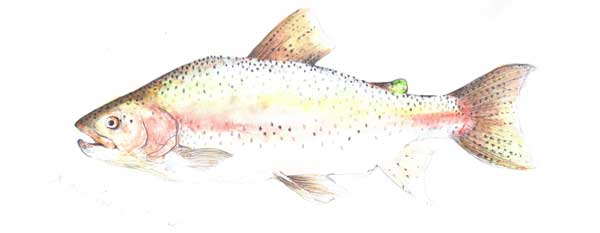
Rainbow Trout (Onchorhynchus mykiss)
Current record: 34lb 12oz
Water: Loch Earn
The rainbow trout (Oncorhynchus mykiss) is a highly esteemed freshwater fish species that is native to North America but has been introduced to many other regions around the world. Its name is derived from the strikingly vibrant, rainbow-like band that runs along its lateral line. Known for its resilience and adaptability, the rainbow trout has become a popular target for anglers and a staple in aquaculture due to its delicious flesh and sporting qualities.
Rainbow trout exhibit a variety of colors, ranging from silver to olive-green on their backs, with a pinkish stripe running along their sides. Their appearance can be influenced by factors such as age, diet, and environmental conditions. In the wild, rainbow trout are typically found in cold, clear rivers and lakes, and they are known for their preference for swift-flowing, oxygen-rich waters.
These fish are opportunistic predators, feeding on a diverse diet that includes aquatic insects, crustaceans, small fish, and even small mammals. Their adaptability to different food sources contributes to their successful establishment in various aquatic ecosystems. In addition to their ecological role, rainbow trout are highly valued in recreational fishing. Anglers appreciate the challenge they pose due to their strong fighting abilities and elusive nature.
Rainbow trout are also extensively raised in aquaculture, contributing to the global demand for fresh and smoked trout products. Trout farms carefully manage water quality, temperature, and feeding to ensure optimal growth and product quality. However, concerns about the potential environmental impacts of escaped farmed trout interacting with wild populations highlight the importance of responsible aquaculture practices.
Conservation efforts related to rainbow trout include habitat restoration projects, water quality management, and regulations on fishing seasons and catch limits. Balancing the needs of both wild and farmed populations is crucial to maintaining healthy ecosystems and sustainable fisheries. Appreciated for its beauty, sporting characteristics, and culinary value, the rainbow trout serves as a flagship species in efforts to preserve and manage freshwater habitats.
In riverine habitats, resident freshwater rainbow trout adults typically weigh between 0.5 and 2.5 kg (1 and 5 lb) but anadromous and lake-dwelling species can grow up to 9 kg (20 lb). Regional and subspecies differences in coloration are significant. Adult freshwater forms typically have thick black spots down the length of their bodies and are blue-green or olive green in colour. The lateral line of adult fish has a broad reddish stripe running from the gills to the tail. Breeding male fish show this stripe more prominently.
Anglers hold rainbow trout and steelhead in high regard as game fish. Fly anglers frequently target rainbow trout, and numerous lure fishing techniques are employed. It is typical to employ lures that are presented via spinning, casting, or trolling tactics. Rainbow trout can also be caught with a variety of natural baits, both live and dead. The rainbow trout is renowned for leaping when hooked and putting up a fierce battle, leading many fishermen to believe that it is the hardest-fighting trout species.